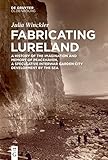Fabricating Lureland : A History of the Imagination and Memory of Peacehaven, a Speculative Interwar Garden City Development by the Sea / Julia Winckler.
Material type: TextPublisher: München ; Wien : De Gruyter Oldenbourg, [2021]Copyright date: ©2022Description: 1 online resource (XIII, 407 p.)Content type:
TextPublisher: München ; Wien : De Gruyter Oldenbourg, [2021]Copyright date: ©2022Description: 1 online resource (XIII, 407 p.)Content type: - 9783110735208
- 9783110734096
- 9783110734027
- 942.257 23/eng
- DA690.P25 W56 2022
- DA690.P453
- online - DeGruyter
- Issued also in print.
| Item type | Current library | Call number | URL | Status | Notes | Barcode | |
|---|---|---|---|---|---|---|---|
 eBook
eBook
|
Biblioteca "Angelicum" Pont. Univ. S.Tommaso d'Aquino Nuvola online | online - DeGruyter (Browse shelf(Opens below)) | Online access | Not for loan (Accesso limitato) | Accesso per gli utenti autorizzati / Access for authorized users | (dgr)9783110734027 |
PhD University of Brighton 2019.
Frontmatter -- Abstract -- Acknowledgments -- Contents -- Prologue -- Chapter 1. Fabricating Lureland: A history of the imagination and memory -- Chapter 2. ‘Own your own bit of England’: Peacehaven’s genesis refracted through British town planning ideals -- Chapter 3. Tracking the visual programme of the Peacehaven Post through the magazine’s first volume -- Chapter 4. ‘No shackles of old tradition to bind her’: The Estate’s emerging topography in the photographs of Joseph James Hill and Frank Parks, 1921–1923 -- Chapter 5. ‘This Blessed Plot, this other Eden’: The Greater Peacehaven development refracted through local and national protests against speculative development from 1923 onward -- Chapter 6. Reading shifting perspectives of Peacehaven 1923–1939 across local guidebooks and other promotional material -- Chapter 7. Peacehaven as memory-space: Intergenerational conversations with long-time residents -- Chapter 8. Evoking Lureland: Site-marking and site-writing the pioneer bungalows of Peacehaven -- Chapter 9. Visions of Lureland survive as allegory -- Primary archival material and archival sources -- Appendix 1. Brief Peacehaven timeline overview -- Appendix 2. Brief biographies of SCLRC staff, Peacehaven Post editorial contributors, early publicists and notable residents -- Appendix 3. Biographies of interviewees -- Index
restricted access online access with authorization star
http://purl.org/coar/access_right/c_16ec
Through the analysis of surviving archival traces, this book constructs a history of the imagination and memory of the town of Peacehaven. Built as a speculative development atop iconic chalk cliffs on the Sussex Coast and marketed as a garden city by the sea, the estate quickly attracted adverse publicity. Influential voices such as the Bloomsbury group’s Virginia and Leonard Woolf, architect and writer Clough Williams-Ellis and the Campaign for the Protection of Rural England soon began to criticise it as a blot on the rolling, pastoral downland. Instead of reading and appraising Peacehaven’s story in a polarized way, this book breaks new ground by critically interpreting visual representations and commissioned photographs of the Estate and re-evaluating propositions from its inception, which aspired to secure improved public health and home ownership in direct response to the negative impact of industrialization and WWI. Focusing on the interwar period and tracing mutating agendas, the book investigates contested marketing and construction narratives through Histoire Croisée methodology and its intercrossings with memory and the imagination. By combining visual and creative research methods with oral history, multi-layered narratives of place come into focus. The study tracks the visual programme of the developer’s in-house magazine, Peacehaven Post, alongside previously underexplored blueprints, photographs, postcards and promotional guidebooks, and considers the garden city narrative as a form of social Utopia. Garden city ideals are once again evoked in debates as a potential solution to the ongoing national housing shortage, giving this research additional urgency as new large-scale redevelopment erases many of the few and fast disappearing original landmarks.
Issued also in print.
Mode of access: Internet via World Wide Web.
In English.
Description based on online resource; title from PDF title page (publisher's Web site, viewed 02. Mai 2023)


